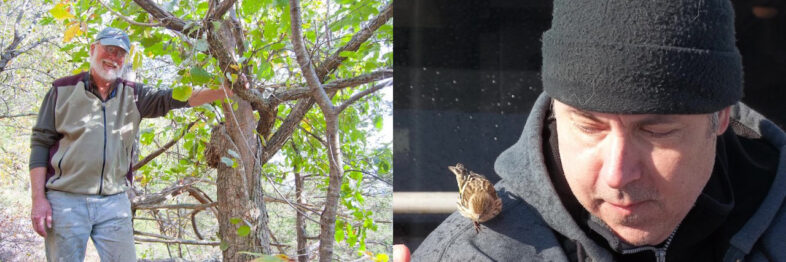After more than a decade of service, two of the first-ever Vermont eBird volunteer data experts are hanging up their keyboards. Ian Worley and Craig Provost first joined the project in 2010. Over the past 13 years, they have reviewed tens of thousands of records submitted by bird watchers and have been outreach champions for Vermont eBird.
In 2009, both responded to a call by VCE Conservation Biologist Kent McFarland for help with reviewing Vermont eBird data. “Vermont eBird became so wildly popular that I just couldn’t come close to keeping up with it myself,” said Kent. “Thankfully, just as Vermont eBird was exploding in popularity, these two joined us with not only incredible bird expertise but also excellent outreach skills. Vermont eBird wouldn’t be the success it is today without them.”
A real-time, online checklist program, eBird, has revolutionized how the birding community reports and accesses information about birds worldwide. The Cornell Lab of Ornithology and National Audubon Society launched the platform in 2002, and this year marks the 20th year for Vermont eBird, the first state portal for eBird. Vermont eBird was founded and is managed by Kent and is a project of the Vermont Atlas of Life. Collaborators on Vermont eBird include Audubon Vermont, Birds of Vermont Museum, Friends of Missisquoi National Wildlife Refuge, North Branch Nature Center, and Vermont Chapters of Audubon, with sponsorship from the Vermont Habitat Stamp.
eBird’s goal is to maximize the utility and accessibility of the vast number of bird observations made yearly by birders. Over the past two decades, Vermont eBird has become the state’s largest and fastest-growing biodiversity database, with nearly 8 million bird records from almost 15 thousand Vermont bird watchers. Every record entered into Vermont eBird is checked for accuracy, first by automated filters with parameters managed by the expert reviewers that flag unusual records and then by the expert reviewers who devote their personal time to ensure the accuracy of the flagged records. These data are the foundation for a better understanding of bird distribution and population trends in Vermont and beyond.
For over a decade, Craig took care of three counties in northeastern Vermont, and Ian was in charge of all the counties bordering Lake Champlain, the busiest birding area in the state. Their first project was to improve the automated filters in their territories to help catch potentially erroneous data. “Adjusting the filters really requires a high level of bird knowledge for these regions,” said Kent. “Years of careful bird watching by the two of them was key.”
What started as reviewing checklists in the Champlain Valley for an hour per week for Ian steadily grew to over 30 weekly hours validating lists for many locations worldwide, spanning the Arctic and northern Atlantic oceans to the Subantarctic Indian Ocean. “I enjoy the global impact one can have as an eBird reviewer,” Ian said.
Both of them have contributed tremendous amounts of data to eBird, too. Ian has surpassed 25 thousand Vermont eBird checklists, and Craig is approaching 20 thousand, representing first and second place all-time for Vermont! In 2020, Craig achieved a birding milestone that precious few Vermont birders will ever realize: he became the second person in history to receive the 14th Star Award, given to those that document 150 species in all of Vermont’s 14 counties, each within a single calendar year.
While they may have wrapped up their incredible stint reviewing records on a computer screen, thankfully, they’ll continue to add copious amounts of data from behind binoculars and help to champion Vermont eBird and the birds we all love. Thank you for sharing your expertise with Vermont eBird and birders! If you run into Craig and Ian while out birding, let them know you are thankful for their hard work and contributions, too.


bon voyage, you two, it was such a pleasure to work with both of you with my submissions. you both are tactful, knowledgeable and approachable, and will be missed.